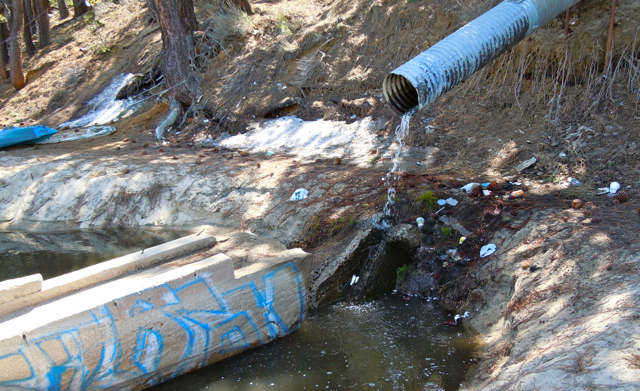Stormwater collection in Tahoe keeps evolving

This storm drain and debris at El Dorado Beach were improved as part of the Lakeview Commons makeover in South Lake Tahoe. Photo/LTN file
By Kathryn Reed
Those tasked with keeping gritty stormwater from reaching Lake Tahoe are looking into whether the roads are actually a problem.
“Pavement wear” is what Russ Wigart, with El Dorado County, called it.
“We completely annihilate our roads on an annual basis,” Wigart said. “Fifteen to 25 percent of fine sediment is from pavement. Maybe we could resurface our roads and call them water quality projects.”
Wigart, along with Jason Burke of South Lake Tahoe and Andrea Buxton of Tahoe Resource Conservation District, all stormwater coordinators, gave a presentation last week at Lake Tahoe Community College about what is going on with runoff in the basin.
Several years ago scientists determined that fine sediment is the main culprit for the diminishing clarity of Lake Tahoe. Much of this comes from runoff from roads, and some from tributaries carrying silt into the larger water body.
With so many roads throughout the Lake Tahoe Basin being categorized as near failing, it stands to reason that ground-up asphalt could be a problem.
The volatile suspendable solids found in the runoff are believed to be the road, Wigart said.
TRCD for three yeas has been monitoring eight catchments around the basin that deliver treated runoff into the lake. More oversight would be ideal, but funding is an issue.
The idea is that with more years of analysis true trends will be able to be established. This will prove if the various treatment systems are working.
TRCD staff sends samples to labs for analysis, monitors the amount of rain/snow that falls, assesses the turbidity (cloudiness), and measures the continuous flow during storms.
The varied erosion control measures that the large landowners are putting in cost millions of dollars. South Lake Tahoe spent $10 million at Sierra Tract and $7 million at Harrison Avenue.
Burke pointed out how retrofitting the city – and any location — after the fact is a more costly endeavor. Ideally, infrastructure like storm drains is put in when a jurisdiction is built. Plus, doing it all after the fact presents contractors with unknowns. When the improvements went in at Harrison a couple years ago five underground fuel tanks were discovered, with two of them being full.